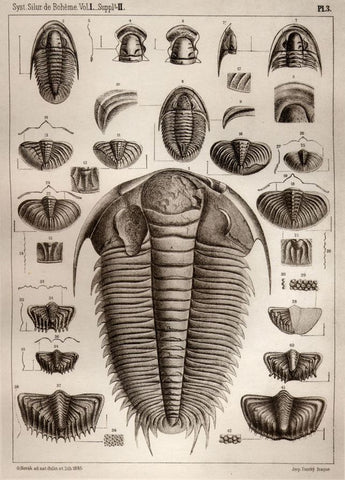Learn About Trilobites
When most people think of fossils, they think of trilobites
Trilobites were a large group marine arthropods with more than 20,000 described species – related to other hard shelled creatures such as crabs, scorpions and insects. They all had jointed legs. The name trilobite refers to the 3 longitudinal divisions of a trilobites body - a central axial lobe with a pleural lobe on each side. Like modern insects, they also have 3 divisions of their body; a head or cephalon, a thorax, and a tail area or pygidium.

- http://www.granit-publishing.cz/?l=en&e=18&k=47&m=
These fascinating ancient creatures lived throughout most of the Paleozoic Era, for about 300 million years. The earliest species date back to the Cambrian Period, about 520 million years ago. Paleontologists have grouped trilobites into 10 distinct Orders, which are extremely varied. A bizarre array of shapes and sizes ranging in size from just over 1 mm to 720 mm. Some types were covered in huge curving spines, reminiscent of many visions of aliens in pop culture.

Source: https://commons.wikimedia.org/wiki/File:Psychopyge_elegans.png
Trilobites swam and crawled through ancient oceans from the Cambrian, Ordovician, Silurian, Devonian Carboniferous and Permian Periods. This planet’s greatest extinction at the Permian/Triassic border 250 million years ago wiped out all of the trilobites as well as 95 % of all marine organisms! Trilobites never had a chance to meet the dinosaurs.
The World’s Largest Trilobite – Discovered in Canada

- World's Largest Trilobite Uploaded by FunkMonk
1999 was a memorable year for trilobite researchers and enthusiast alike. The world’s largest trilobite – Isotelus rex was discovered on the frigid shores of Hudson’s Bay in northern Manitoba, Canada - the summer home of large numbers of polar bears.
In a joint expedition of the Royal Ontario Museum (ROM) and Manitoba Museum and University of Manitoba, Isotelus rex a trilobite of the Asaphida order was discovered and carefully extracted from the late Orodovician rocks near Churchill Manitoba. During the Ordovician Period 445 million years ago when Isotelus crawled along the ocean sea floor, Churchill was located near the present day equator – it lived in a warm, tropical environment.
In comparison to other trilobites, Isotelus was a monster measuring in at 720 mm in length and 400 mm wide! That’s about 28 inches by 15 inches. No other species of trilobite has come close in size. Paleontologists believe that the gigantic size of this trilobite was a result of low altitude gigantism.
The gorgeous pyritized Triarthrus eatoni trilobites on FossilRealm.com are small when compared to Isotelus but make up for it with the incredibly rare preservation of soft body parts including traces of the gut, legs and even gills. Triarthrus had an extremely thin shell or cuticle. It is classified in the order Ptychopariida in the family Olenidae.
View all trilobites for sale on FossilRealm.com, including our beautiful pyritized Triarthrus specimens.
Want to learn more about trilobites? This site has extensive information on trilobites.

